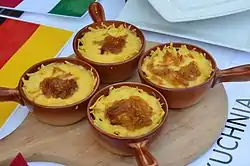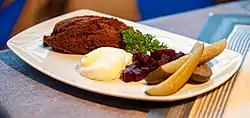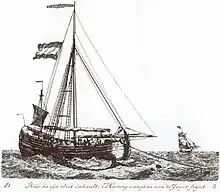 Odesa Jewish-style vorschmack served on rye bread | |
| Course | Hors d'oeuvre, Zakuski |
|---|---|
| Region or state | Eastern Europe, Ashkenazi Jewish diaspora |
| Associated cuisine | Ashkenazi Jewish, American Jewish, Finnish, German, Israeli, Ukrainian Jewish, Ukrainian, Polish, Russian |
| Main ingredients | Ground meat and/or fish |
Vorschmack or forshmak (Yiddish: פאָרשמאק; from archaic German Vorschmack, "foretaste"[1] or "appetizer"[2]) is an originally East European dish made of salty minced fish or meat. Different variants of this dish are especially common in Ashkenazi Jewish and Finnish cuisine. Some varieties are also known in Ukrainian,[3] Polish and Russian cuisine.
In Jewish cuisine
According to Gil Marks, the German name points to the possible German origin of this dish.[1] William Pokhlyobkin describes it as an originally East Prussian hot appetizer which was made of fried herring.[4] The dish was adopted and brought eastwards by Ashkenazi Jews which transformed it into a cold appetizer, a pâté made of chopped brined herring.[1][4] While the name forshmak became common in Ukraine (Yiddish: פֿאָרשמאַק, Ukrainian: форшмак), Polish and Lithuanian Jews usually called it gehakte herring ("chopped herring").[1]
Traditional recipes include chopped hard-boiled egg, onion and grated fresh apple.[5] Sometimes potatoes are also added.[1] The appetizer is usually served as a salad or as a spread on bread, crackers or kichlach (cookies).[1] It may also be eaten for breakfast or as a main course, usually with boiled potatoes.[1][4]
In Russian cuisine

Although nowadays vorschmack is mainly associated with Jewish cuisine in Russia,[4] historically different versions of this dish (Russian: форшмак) were known there. These were usually hot zakuski (appetizers) or breakfast dishes. A Gift to Young Housewives, a classical Russian cookbook by Elena Molokhovets, provides three recipes of hot vorschmack in its first edition (1861) and further variants were added in subsequent editions. In one recipe, meat (veal or beef), herring, white bread and onions are minced, mixed with smetana (sour cream) or cream and baked. Other recipes include only herring (without meat), as well as other ingredients, such as potatoes, eggs and apples.[6] Even more elaborate recipes with further details on cooking techniques are given in another classical Russian cookery textbook, The Practical Fundamentals of the Cookery Art (1899–1916) by Pelageya Alexandrova-Ignatieva. It was in particular proposed to place the mixture of minced ingredients inside a kalach, cover it with grated cheese and bake it au gratin.[7] Similar recipes also appear in Cookery (1955), a major cookbook of Soviet cuisine.[8]
In Polish cuisine
As a cold pâté or a hot baked appetizer, various recipes of forszmak (the same pronunciation) are found in old Polish cookery. The recipes are similar to the Russian ones described above.[9][10][11] Another variety, a meat stew named forszmak lubelski is known in East Poland (Lublin region), usually made of chopped meat (beef, pork, or chicken), pickled cucumbers, and tomato paste.[12]
In Finnish cuisine

In Finnish cuisine, vorschmack is usually prepared out of ground meat, anchovies or herring and onions. The dish is usually garnished with potatoes, pickles and smetana (sour cream). Snaps is usually served in combination with eating vorschmack. Some recipes include cognac.[13]
There are several stories regarding the origin of the dish, but it has become a traditional Finnish dish as it was one of the favourite appetizers of the Finnish president, statesman, war hero and gourmand Marshall Gustaf Mannerheim. Some sources say Mannerheim brought the dish to Finland from Poland[14] or Russia,[15] but there have not been any definite sources for these claims.
The restaurant Savoy at the top floor of one of the buildings around the Esplanadi in central Helsinki is famous for its vorschmack. The restaurant used to be frequented by Mannerheim and Mannerheim's table at the Savoy was always reserved and, out of respect, no one would ever consider demanding to be seated there. Savoy still today keeps a similar style decor and menu as in the days of Mannerheim.
See also
References
- 1 2 3 4 5 6 7 Gil Marks. Encyclopedia of Jewish Food. Houghton Mifflin Harcourt, 2010. Forshmak
- ↑ Max Vasmer (1953–1958). "Vorschmack". Russisches etymologisches Wörterbuch (in German). Heidelberg: Winter. "Форшмак". Этимологический словарь русского языка. Russian translation by Oleg Trubachyov. Moscow: Progress. 1964–1973.
{{cite encyclopedia}}: CS1 maint: others (link) - ↑ Українська кухня минулого і майбутнього: головні тези UKRAINIAN GASTRO SHOW / Що готували: Форшмак з товстолоба
- 1 2 3 4 В. В. Похлебкин. Национальные кухни наших народов. Москва, изд. Пищевая пром-сть, 1980. Еврейская кухня Archived 2017-12-31 at the Wayback Machine. (William Pokhlyobkin. The Ethnic Cuisines of our Peoples. Moscow, Food Industry publishing house, 1980; Russian)
- ↑ Claudia Roden, The Book of Jewish Food, Penguin Books, 1999, p. 62
- ↑ Елена Молоховец (1861). Подарок молодым хозяйкам (in Russian). Санкт-Петербург.
{{cite book}}: CS1 maint: location missing publisher (link) A Gift to Young Housewives, English translation: Joyce Stetson Toomre (1998). Classic Russian Cooking: Elena Molokhovets' a Gift to Young Housewives. Indiana University Press. ISBN 978-0-253-21210-8. - ↑ Пелагея Павловна Александрова-Игнатьева (1909). Практические основы кулинарного искусства. Санкт-Петербург. pp. 600–602.
{{cite book}}: CS1 maint: location missing publisher (link) [Pelageya Alexandrova-Ignatieva (1909). The Practical Fundamentals of the Cookery Art (in Russian). St. Petersburg.{{cite book}}: CS1 maint: location missing publisher (link)] - ↑ 401. Форшмак из мяса в калаче, 798. Форшмак из сельди, 888. Форшмак из говядины, 1479. Форшмак из овощей. П. В. Абатуров; et al. (1955). М. О. Лифшиц (ed.). Кулинария. Москва: Госторгиздат, Министерство пищевой промышленности СССР. [P. V. Abaturov; et al. (1955). M. O. Lifschitz (ed.). Cookery (in Russian). Moscow: Gostorgizdat, USSR Ministry of Food Industry.]
- ↑ Hanna Szymanderska (2005). Na polskim stole, przepisy i tradycje szlacheckie (in Polish). Świat Książki. p. 368. ISBN 978-83-247-0090-5.
- ↑ Andrzej Kozioł (2002). Polski słownik kuchenny i biesiadny (in Polish). Text. p. 68. ISBN 978-83-8893414-8.
- ↑ Maja i Jan Łozińscy (2012). Historia polskiego smaku. Wydawnictwo Naukowe PWN. p. 282. ISBN 978-83-01-17102-5. Forszmak według Ćwierciakiewiczowej
{{cite book}}: External link in|postscript= - ↑ "Forszmak Lubelski". Retrieved 2019-11-09.
- ↑ "Marskin Vorschmack". Suomikauppa.fi.
- ↑ "Marskin Vorschmack". Nordic Deli Oy. 2016.
- ↑ Fred Ferretti (1994). Pearl Violette Metzelthin (ed.). "Helsinki Tastes, From Vorschmack To Garlic". Gourmet. Vol. 54. Condé Nast Publications. p. 82.

